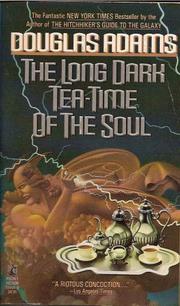Wednesday, June 9, 2010
The Body in the Library by Agatha Christie
Agatha wrote The Body in the Library almost as a joke. She acknowledged that finding "a body in the library" was an English detective novel cliche and this book was her amusing take on it. She name checks herself when a small boy says he has lots of detective novelists' autographs and her name is among those he lists. And although Miss Marple is the star of the novel and the solver of the mystery, there are as many detectives here as there are suspects, with Sir Henry Clithering (another recurrent character) helping out in addition to the three different official police detectives. This is only Miss Marple's second appearance in a Christie novel, her first being The Murder at the Vicarage in 1930, 12 years earlier.
Monday, June 7, 2010
Thinking in Pictures: My Life With Autism by Temple Grandin
Temple Grandin is about 6 years older than my parents. She was diagnosed with autism in 1950 (after a previous false diagnosis of brain damage) at a time when most autistics would have been institutionalized. On the very high functioning end of the autism spectrum and given early special education opportunities and tutoring at the insistence of her mother, Grandin is now a professor with a Ph.D. in animal science, an inventor, an entrepreneur, a best-selling author, a public speaker, and an autism and animal welfare advocate. She is most famous not only for being the designer of one third of all the livestock-handling facilities currently in use in this country, but also for being one of the first adults to be able to speak out about what it is like to have autism, how autistics see the world, and why autistic people behave the way they do.
In Thinking in Pictures, Grandin writes about all of these issues and about how her autism has helped her to see the world from "a cow's eye view" to be able to design better, more humane ways of handling animals in slaughterhouses and veterinary procedures. She says she thinks visually and can run images in her mind like watching a movie, which helps her to invent machines and facilities without having to build models or test them repeatedly in real life. She says she feels she can understand better than neurotypical people how animals think and feel and how they perceive the world around them, so she strives to find ways to make their experiences with humans less fear-ridden and more peaceful. She also gives a lot of advice about how normal people who work or live with autistics can help them reach their potential and feel calmer and more secure, which in turn may help them to interact more on an interpersonal level.
I highly recommend this book to all my teacher friends who increasingly come into contact with students on the spectrum. It's fascinating to read Grandin's personal accounts of how she felt as a child and feels as an adult with autism and how she perceives the world, in addition to her reports of the experiences of other people she has met who have different forms of autism. I would also recommend it to my cousin who is a veterinarian, or anyone who is interested in animal welfare, because even I thought the stuff she writes about animals' minds and their handling was pretty fascinating.
Additionally, far from being dry or overly erudite, Thinking in Pictures is a fairly quick and easy read. Apparently, Grandin has her writing heavily proofread for readability and clarity and it is remarkably approachable. She often uses computer metaphors to describe her thinking, but thankfully her book never reads like stereo instructions. It's an incredibly engrossing, very human (and bovine!), fascinating story she has to tell.
In Thinking in Pictures, Grandin writes about all of these issues and about how her autism has helped her to see the world from "a cow's eye view" to be able to design better, more humane ways of handling animals in slaughterhouses and veterinary procedures. She says she thinks visually and can run images in her mind like watching a movie, which helps her to invent machines and facilities without having to build models or test them repeatedly in real life. She says she feels she can understand better than neurotypical people how animals think and feel and how they perceive the world around them, so she strives to find ways to make their experiences with humans less fear-ridden and more peaceful. She also gives a lot of advice about how normal people who work or live with autistics can help them reach their potential and feel calmer and more secure, which in turn may help them to interact more on an interpersonal level.
I highly recommend this book to all my teacher friends who increasingly come into contact with students on the spectrum. It's fascinating to read Grandin's personal accounts of how she felt as a child and feels as an adult with autism and how she perceives the world, in addition to her reports of the experiences of other people she has met who have different forms of autism. I would also recommend it to my cousin who is a veterinarian, or anyone who is interested in animal welfare, because even I thought the stuff she writes about animals' minds and their handling was pretty fascinating.
Additionally, far from being dry or overly erudite, Thinking in Pictures is a fairly quick and easy read. Apparently, Grandin has her writing heavily proofread for readability and clarity and it is remarkably approachable. She often uses computer metaphors to describe her thinking, but thankfully her book never reads like stereo instructions. It's an incredibly engrossing, very human (and bovine!), fascinating story she has to tell.
Subscribe to:
Posts (Atom)

